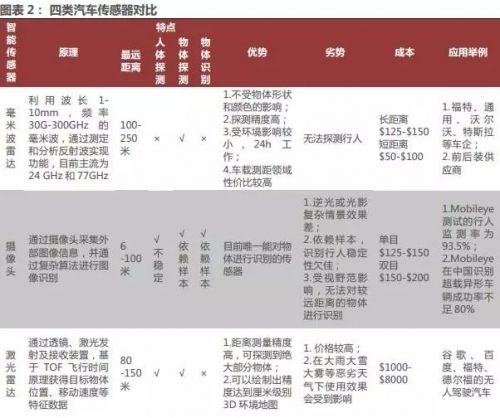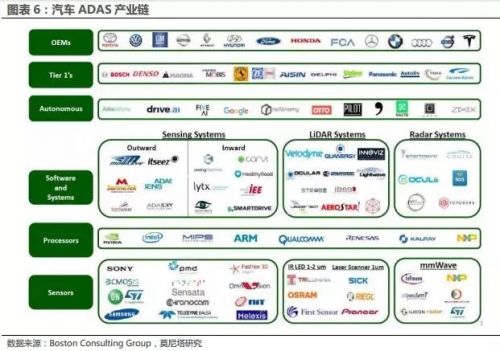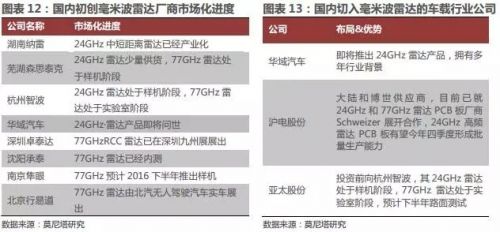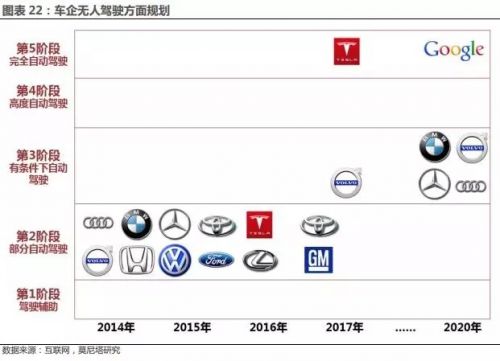Automotive sensor types and development trends
1. Sensors are the eyes of the car, playing a vital role in ADAS and autonomous driving systems.
As advanced driver assistance systems (ADAS) and fully autonomous driving develop, the machine gradually takes over the driver's responsibilities, performing tasks such as environmental perception, data analysis, and control execution.
The first step in this process is using sensors to perceive the surrounding environment. Common sensors used in automotive systems include radar, ultrasonic sensors, cameras, and lidar. Each has its own strengths and applications.

2. Currently, the main technologies include millimeter wave radar, camera, lidar, and infrared.
Different sensors operate on different principles and serve distinct functions, making them complementary rather than interchangeable.
Millimeter wave radar is not affected by weather, has a long detection range, and is cost-effective for vehicle distance sensing, but it struggles with identifying pedestrians or traffic signs.
Cameras offer low cost and strong object recognition capabilities, essential for lane departure warnings and traffic sign detection, but they depend on lighting and may fail in adverse weather conditions.
Lidar provides high precision and real-time 3D mapping, commonly used in self-driving vehicles like Google and Baidu, but it is expensive and less effective in rain, snow, or fog.
Infrared technology is mature and often used in short-range collision avoidance systems, typically found in reversing radars. Ultrasonic radar is cost-effective for short-range applications such as parking assistance.

3. Governments around the world have introduced policies to promote ADAS adoption.

The current penetration rate of ADAS systems is only 8%–12% globally, and even lower in some regions. With policy support and the influence of consumer electronics scale, the automotive sensor industry is expected to grow rapidly. According to IHS Automotive, the global anti-collision sensor market reached $3.94 billion in 2014, and is projected to reach $9.9 billion by 2020.
4. OEMs and Tier 1 suppliers remain the key players.
Automotive sensors require high safety and stability standards, so the development is primarily driven by OEMs and Tier 1 manufacturers. These companies have already established their R&D and collaboration models.
Many startups today partner with OEMs, who then distribute to Tier 1 suppliers. Although they haven’t made big headlines yet, the overall direction is promising, and there will be more opportunities in the future.

Millimeter Wave Radar
A millimeter wave radar consists of an antenna, RF front-end chip, and DSP signal processing unit. The MMIC (Monolithic Microwave Integrated Circuit) and high-frequency PCB board are critical components.
Currently, MMICs are dominated by foreign companies, especially 77GHz chips controlled by Infineon, ST, and Freescale. Domestic MMIC development is still in early stages, mainly focused on 24GHz radar. Companies like Huayu Automobile and Wuhu Senstek have made progress in existing products.
High-frequency PCB boards are also largely imported, with Schweizer holding a 30% share in the global market. Domestic manufacturers lack technical expertise and rely on imported materials. Hudian supplies PCBs to Bosch and others.
The cost of long-range radar modules ranges from $60 to $120, while short-range ones are about $30–$40. Cost breakdown includes antenna & PCB, RF front-end, and DSP. Foreign companies also charge significant software licensing fees, sometimes in the millions.
The millimeter wave radar market is highly concentrated, dominated by German, American, and Japanese companies like Bosch, Continental, Hella, and Denso. In 2015, the top three—Bosch, ZF, and Hella—accounted for over 50% of the market.

Currently, all high-end car radar systems in China are imported. Domestic R&D has completed the first phase, with 24GHz radar products expected to launch in Q4 2016. These will focus on blind spot detection and lane change assistance. Future phases aim to reduce costs and bring 24GHz products to market by next year.
Camera System Industry Chain
Car cameras are the visual sensors of ADAS systems. After capturing images, the photosensitive component processes them into digital signals that can be analyzed by computers, enabling functions like forward collision warning and pedestrian detection.
The general process involves image processing, pattern recognition, and motion-based distance estimation. Hardware includes CMOS lenses, chips, memory, and casing. Monocular cameras are most common.

Software improvements, like those by Mobileye, involve increasing processing power and resolution. Most vendors focus on specific parts of the supply chain.
Lens manufacturing is dominated by Taiwanese companies, while mainland firms have advantages in infrared filters. Image sensors are mostly European, American, and Korean. Module production is led by Chinese, South Korean, and Japanese manufacturers.

Monocular cameras will remain dominant, with future cars likely to have six cameras for 360-degree vision. Global shipments are expected to grow at 11.3% annually, reaching 83 million units by 2020.
Binocular cameras may see breakthroughs in the next five years, with companies like Tras exploring multi-purpose solutions. Chip advancements, such as EyeQ5, will drive future growth.
Future Market Outlook
1. Mainstream automakers began deploying second-stage autonomous features in 2014.
Many brands started implementing partial autopilot systems in 2014, with continued upgrades as technology matures.

2. The automotive sensor market is expected to reach $9.9 billion by 2020.
In 2014, ADAS penetration was around 15% in developed markets, but only 3% in China. With stricter regulations and growing demand, ADAS will become standard in basic models by 2020.
According to Isuppli, the global and Chinese ADAS markets were estimated at $6 billion and $1.5 billion in 2016, and are expected to reach $30 billion and $3 billion by 2020.
Fork Type Terminals,Insulated Bullet Sockets Terminals,Insulated Bullet Terminals,Type Fork Insulate Terminal
Taixing Longyi Terminals Co.,Ltd. , https://www.txlyterminals.com